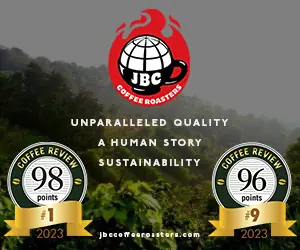As part of a just completed trip to Kenya, I visited some farms and coops in the classic Kenya growing regions northeast of Nairobi. Before arriving at the coffee, however, we enjoyed a day’s run past giraffes, rhinos and other impossible creatures around Lake Nakuru, a lake particularly famous for the clouds of flamingos that turn the pale blue water of the lake pink with their reflections. Not as many flamingos as usual, we were told, although I certainly was impressed. The lake has shrunk owing to drought and man-made deforestation in the hills that ring the lake and we were told that many flamingos have sensibly flown off to feed in other, less shrunken lakes.
I had expected more commercialization. The wildlife was genuinely wild, going about its collective, dreamlike existence almost completely oblivious of the occasional pop-top minivan full of tourists and cameras. The only moment to invoke true urban cynicism occurred when one of the drivers spotted a leopard (a rare sighting apparently) and let the other drivers in the vicinity know, whereupon all the minivans in the area converged, causing a kind of traffic jam. The leopard, meanwhile, a distant lump sleeping on a dead tree branch, did absolutely nothing of note except sleep.
There are probably three – no four – reasons that fine Kenya coffees are consistently among the best in the world. Reason one: they grow in deep, old volcanic soil. Reason two: they grow at high elevations near the equator. Reason three: they are meticulously wet-processed using traditional ferment-and-wash methods – no machines scrubbing the fruit pulp off the beans as is now increasingly the case in Latin America. At least there were no such machines in evidence among the farms we visited.
Reason four for the superiority of Kenyas is controversial: to what degree are the traditional botanical varieties grown in Kenya and derived from the great heirloom Bourbon variety responsible for the amazingly rich, sweetly tart dry berry notes for which the best Kenyas are famous? These heirloom varieties are the famous SL28 and SL34 (SL stands for “Scott Laboratories”). Unfortunately, the trees of these varieties, like most other traditional varieties in Kenya, are susceptible to coffee berry disease, or CBD, the scourge of Kenya coffee.
As we dozed our way in stuffy minivans from farm to farm in Kenya my particular mission was learning more about the question that obsesses the more knowledgeable admirers of Kenya coffees: Will new plantings of a recently developed CBD-resistant, high-yielding variety of Arabica called Ruiru 11 turn Kenya coffees sappy and ordinary? Will that amazing rich black currant note, already rare, disappear entirely?
Ruiru 11 is something of a coffee scientist’s triumph, representing the culmination of years of work crossing the flavor-positive SL28 with varieties that incorporate the disease resistance of Robusta as well the genetic stability of certain other arabica varieties.
The agronomists and the farmers I spoke to at first unanimously said that Ruiru 11 tastes fine. For example, our tireless and exuberant tour leader, Etienne Delbar, Chairman of the Kenya Chapter of the East Africa Fine Coffee Association, claimed during the first night the group met that no one can tell the difference in the cup between coffee from trees of the Ruiru 11 variety and the heirloom SL28.
Maybe that one time they couldn’t. But I doubt whether they would be fooled over the long run. That elegant dry berry sensation pops up everywhere in the world where Bourbon and its derivatives are grown. Not every year, not on every farm, but regularly enough to decisively convince anyone who recognizes the note and cups enough coffees that this beautiful note is related to bourbon and bourbon-related varieties.
But once past the simple black-and-white assertion – there’s no difference, just you coffee snobs causing us hard-working farmers and smart agronomists problems – the more thoughtful agronomists I spoke to nuanced the situation. Essentially, they admitted the Ruiru 11 cup is sometimes simple and empty, but the reason, they say, is that farmers don’t prune these new Ruiru 11 trees aggressively enough, so they simply produce too much coffee with a diffused or empty character. Cut the Ruiru 11 trees back so that they bear less fruit and the coffee they produce will taste just like coffee from the lower-bearing SL28 and SL34.
One problem is farmers may not aggressively prune their Ruiru 11 because they naturally want to produce more coffee, sell more coffee, and make more money. Hence, on a practical level, more Ruiru 11 probably will mean more ordinary tasting Kenyas entering the market. Secondly, although the Ruiru 11 coffee from strategically pruned trees may be outstanding coffee, I still doubt – at least until I taste enough samples – that it will reflect the dry berry character we treasure from the best Kenyas.
The last agronomist I spoke to was quite familiar with the dry berry character, but declared with great confidence that it has nothing to do with botanical variety and is purely owing to the influence of the deep, old volcanic soil of the prime Kenya growing areas.
In part, perhaps, but not completely. True, you can’t just grab some SL28 seed and plant it on some mountain in another part of the world and expect it to taste like the finest Kenyas. Terroir counts. But so does botanical variety. We eventually will understand better how botanical variety and terroir (the sum total impact of soil, climate, and typography) interact together to produce the handful of very distinctive coffees many of us treasure. But for now, and for Kenya, I don’t believe it’s terroir alone.










